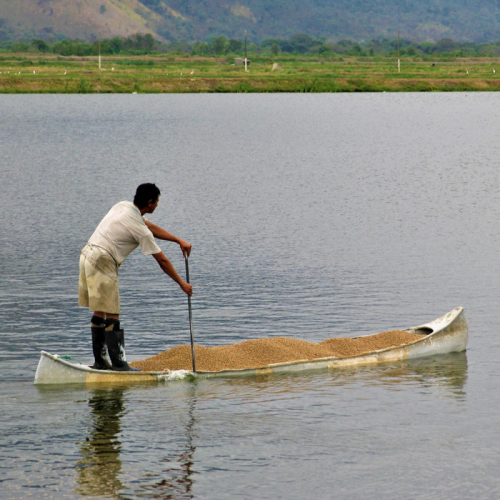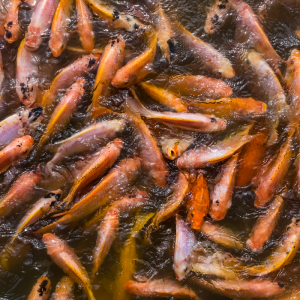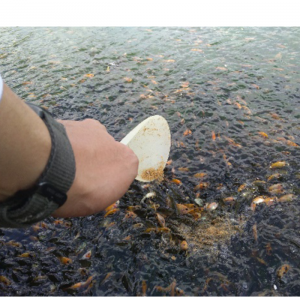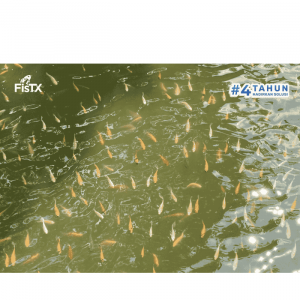
Enhanced Biodiversity of Gut Flora, Feed Efficiency in Nile Tilapia Under Reduced-frequency Feeding
| Wed, 03 Mar 2021 - 16:28
Tilapia and many other fish species are grown predominantly in pond culture under various conditions. These include intensive culture, with high stocking densities, reliance on commercial feeds, and often requiring mechanical aeration of the ponds; extensive culture, where fish are stocked at low densities and organic and inorganic fertilizers stimulate pond primary food production with little to no additional feed supplementation; and, most frequently, semi-intensive culture conditions in which fish are stocked at moderate densities and provided supplemental feeds to complement microorganisms produced naturally with pond fertilization, which can effectively quadruple production over extensive culture systems.
Feed is a major expense in aquaculture, comprising up to 50 to 70 percent of the total production costs for cultured tilapia. Methods to limit the amount of feed can help reduce overall costs to producers and has major impacts on small-scale farmers that dominate in underdeveloped countries.
Reductions in feed ration by up to 50 percent by using alternate-day feeding improves the feed efficiency and economic returns of tilapia monocultured at densities of 2 to 4 fish per square meter with little impact on growth, survival or production yield.
A better understanding of how finfish acquire and utilize nutrient inputs is required to improve aquaculture production efficiency. The underlying mechanism explaining how reduced frequency or alternate-day feeding strategies can achieve equivalent production yields with less feed is poorly understood in finfish.
Also read: Prevention and Treatment Of Streptococcal Disease in Tilapia
Some evidence suggests that during periods of fasting, nutrient uptake efficiency in the intestine is intrinsically enhanced, leading to a more-efficient uptake of nutrients at the next feeding period
Additionally, reduced feeding may promote foraging on primary food production within the ponds, leading to a more diverse diet (e.g. algae, insect larvae, plankton), enhancing nutrient recycling within the ponds. This enhanced diversity may directly influence intestinal absorption by promoting colonization and growth of microbes that may aid in nutrient utilization and uptake efficiency that are key to growth and health of the fish.
It is currently unknown as to how reduced frequency feeding strategies may alter the gastrointestinal microbiome and nutrient transporter gene expression of tilapia resulting in better nutrient utilization and feed efficiencies.
This article – adapted and summarized from the original publication (Salger, S.A. et al. 2020. Enhanced biodiversity of gut flora and feed efficiency in pond cultured tilapia under reduced frequency feeding strategies) – reports on a study that evaluated potential underlying mechanisms behind the greater feed efficiency in fish fed on alternate days.
Study setup
In this study, we evaluated the practices of alternate-day feeding to both establish whether this practice is effective in other areas of the world and to determine if changes in the tilapia gastrointestinal microbiome and nutrient transporter gene expression might account for improved feed efficiency under the management practice. We also sought to assess if reducing the frequency further to every third day might further improve production efficiency of tilapia.
The tilapia growth trial was carried out at the Fisheries Field Laboratory, Bangladesh Agricultural University, Mymensingh, Bangladesh. All-male sex reversed Nile tilapia (~3.5 grams) were stocked at five fish per square meter in 16 ponds (0.1 hectares; four replicates per treatment), with weekly pond fertilization at a rate of 28 kg of nitrogen and 7 kg of phosphorus per ha per week for all treatment groups.
Twenty ponds were randomly divided into one of five treatments (four ponds per treatment). The treatments were: (T1) commercial diet feeding daily with weekly pond fertilization, (T2) commercial diet feeding every other day with weekly pond fertilization, (T3) commercial diet feeding every third day with weekly pond fertilization, (T4) weekly pond fertilization with no supplemental feeding of commercial diet and (T5) daily feeding with commercial diet with no pond fertilization.
Fish were fed with a local, commercial formulated feed (CP Bangladesh, 30 percent crude protein), initially at 10 percent and then down to 3 percent body weight per day based on a standard tilapia feed schedule.
Also read: Study Tests Autogenous Vaccine to Protect Nile Tilapia
Growth (length and weight) was monitored at two-week intervals by subsampling of fish over the 12-week growing trial. Feed rates were adjusted accordingly based on this biweekly random sampling of 50 tilapia from each pond. After approximately 12 weeks (day 114 of the trial), all fish were harvested by seining the fish from the ponds. All fish were collected, counted, weighed and measured to assess survival rate and total production.
Samples of tilapia anterior intestinal tissue and fecal material from the colon were collected for various analyses at North Carolina State University, Raleigh, N.C., USA.
For detailed information on the experimental design and fish husbandry; water quality; collection of various fish production data and samples and their analyses; and statistical analyses, refer to the original publication.
Results and discussion
Our results showed no difference in growth parameters or survival in tilapia fed on alternate days versus those fed daily. Nile tilapia fed on alternate days had improved feed efficiency and a greater diversity of gut prokaryotic [cellular organism that lacks an envelope-enclosed nucleus] and eukaryotic [organisms whose cells have a nucleus enclosed within a nuclear envelope] microorganisms, while transcript levels of select nutrient transporters changed little in fish fed on alternate days versus those fed daily, every third day or not at all.
It is estimated that 50 to 70 percent of total variable costs for growing tilapia and many other fishes is attributable to formulated feeds. Our study demonstrated that alternate-day feeding along with pond fertilization reduces the costs of feeds for growout of Nile tilapia by 50 percent, increases feed efficiency by 76 percent and has little impact on growth, survival or yield of fish farmed in ponds. This is noteworthy as both ponds fed every day with (T1) or without (T5) pond fertilization had the highest expenditures in our study while ponds that were fertilized only (T4) with only pond fertilization had the lowest cost input.
Tilapia producers could see a marked reduction in production costs and the highest benefit: cost ratio (BCR) largely due to the reduced feed costs associated with alternate-day feeding strategies.
The overall improved capacity of fish fed on alternate days to utilize nutrients for growth (lower feed conversion ratio, FCR) was accompanied by other factors including intermediate expression of some genes and high diversity of gastrointestinal prokaryotes and eukaryotes, suggesting that these factors along with the higher biodiversity of organisms available for consumption (commercial diet and natural pond productivity) may contribute to enhanced feed efficiency while sustaining similar growth and health of tilapia when fed daily.
We also assessed how the gut microbial flora is altered by feeding and fertilization strategies that could potentially identify microbes beneficial to tilapia growth and health. The establishment of beneficial gut flora to increase nutrient absorption is an emerging research focus in human biology and aquaculture science and may serve to augment existing practices of sustainable feeding and reduction in environmental footprint.
Also read: Can Natural Male Tilapia Tackle Emerging Diseases?
The most abundant phylum of prokaryotes identified in all treatments were the Firmicutes, important members of the gut microbiome of many vertebrates. The proportions of Firmicutes identified declined with reduced application rates of commercial feed in fertilized ponds.
An increase in the relative abundance of Firmicutes is positively correlated with caloric intake in bony fishes. The higher proportion of Firmicute bacteria in tilapia from treatments fed daily in fertilized ponds in our study indicates that there may be an abundance of high-calorie food sources available to these fish. Bacteria from Fusobacteriaceae and Clostridiaceae were most abundant in the fecal material of Nile tilapia used in our study.
The highest growth and survival rates were observed in T1 (daily feeding along with pond fertilization), T2 (alternate day feeding along with pond fertilization) and T5 (daily feeding only). We identified seven operational taxonomic units, OTUs [an operational definition used to classify groups of closely related individuals], including those of Acutodesmus sp., Cyanobacterium sp., Bacillus sp., Blautia sp., Anaerovorax sp., Sphingomonas sp. and Desulfococcus sp.) that were common between all three of these treatments.
The identification of the species relating to these OTUs are currently unknown. Future work will be necessary to determine not only the species but also the exact functions of these microorganisms and to determine whether they might serve to benefit growth of Nile tilapia.
Six families of eukaryotic phytoplankton and four groups of zooplankton were identified from the ponds in this study. Of those identified, plankton from the families Bacillariophyceae, Chlorophyceae, Euglenophyceae, Rhodophyceae, Subphylum Crustacea and Phylum Rotifera were also identified in the microbial communities in the fecal material from the Nile tilapia in these studies.
The commonalities with fecal matter data indicate that the tilapia were consuming plankton from the pond as an additional food source.
Tilapia in this study were feeding on a wide variety of eukaryotic organisms in the ponds. Being omnivores, tilapia will utilize any food resources available to them for growth and as such a decrease in the application frequency of the commercial feed would likely increase the rates of consumption of natural food sources, whether that be planktonic sources or plant material growing in the ponds.
Also read: Tilapia Pass Benefits of Streptococcus Vaccine to Their Offspring
Tilapia in T2 (alternate day feeding along with pond fertilization) had the greatest diversity of eukaryotic organisms identified in their guts. This could have led to a greater variety of nutrients available to them for growth than the tilapia in the other treatment groups.
It is likely that pond fertilization alone is beneficial for growing tilapia as it increases the availability of natural food sources providing a more varied diet. Alternate day feeding appears to also be beneficial for enhancing microbe diversity as these fish are likely consuming a greater proportion of plankton and plant materials than those fed daily.
Our results suggest that the optimal BCR and net return for tilapia production occurs when fish are fed on alternate days in fertilized ponds. Tilapias are omnivorous and readily feed on diverse food sources throughout their life, including phytoplankton and zooplankton or other natural pond foods enhanced through fertilization or application of supplemental formulated feeds.
Hence, tilapia fed on alternate or even every third day likely forage at a greater rate between meals on pond organisms produced through enhanced nitrogen and phosphorous inputs from fertilizers or feeds than fish fed daily. Less reliance on supplemental feeds will increase overall feed efficiency as demonstrated here with low FCR, albeit at a detriment to growth when animals are fed at a frequency of every three days.
Perspectives
It is estimated that formulated aquafeeds are 50 to 70 percent of the total variable costs for growing tilapia. Results of our study demonstrated that alternate-day feeding reduces the costs of feeds for grow-out of tilapia by 50 percent, increases feed efficiency by almost 76 percent, and has little impact on growth, survival or yield of tilapia farmed in ponds.
The results also suggest that tilapia grown in fertilized ponds without supplemental feeds may be nutritionally impaired, as key nutrient transporters in the gut are enhanced in preparation for increased uptake of solutes should food become available, a process that is mitigated when animals are provided supplemental aquafeeds. The intermediate expression of gut nutrient transporters in alternate-day fed tilapia may reflect a condition for the most efficient uptake of nutrients from the GI tract.
Our research shows that the use of fertilizers and the implementation of an alternate-day feeding strategy increase the diversity of intestinal microbiota that may function in promoting nutrient assimilation in tilapia. These microbes may serve as promising candidates for isolation and development of probiotics beneficial to increased feed efficiency, growth and health in tilapia.
Overall, this is the first study to suggest that enhanced gut microbial diversity may contribute to improved feed utilization under reduced frequency feeding strategies in the culture of Nile tilapia and perhaps other finfish.
Source: Global Aquaculture Alliance






















